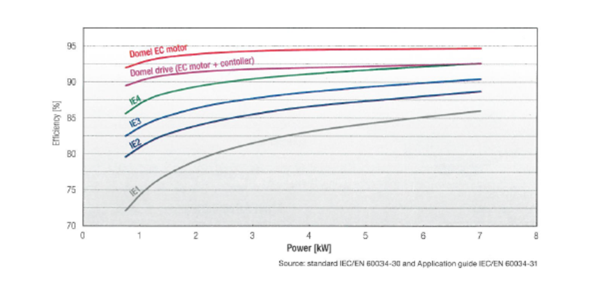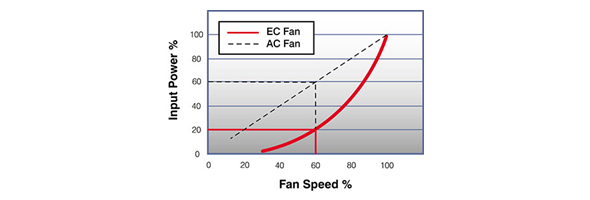ENERVEX is currently in the process of replacing all AC motors with Domel EC motors using a proprietary EDrive (VFD). Why are we taking such a drastic step? To help our customers exceed global expectations for energy-efficient exhaust and venting systems.
MARKET-DRIVEN INNOVATION
One of the biggest influences of motor and drive product innovation continues to be energy-efficiency regulations. Electric motor manufacturers are currently operating under the Energy Independence and Security Act of 2007, which went into effect on December 2010. The Act is updated every five years and the current efficiency level is Premium Efficiency for 1 to 500 HP motors.
The motor manufacturers widely agree that energy efficiency, whether mandated by the Department of Energy (DOE) or by the market itself, will continue to influence motor and drive technologies. Efficiency is taking over; the push for green applications and the ability to lower power bills is driving these trends. Regulation is playing a part, but many of the current high-efficiency systems are exceeding legislated levels. The industry is pushing for efficiency and is clearly willing to pay for it.
So, the efficiency level will be raised to above the Premium level during the next update, which will force the use of EC motors in a lot of commercial applications, including all of the ones ENERVEX serves.
This chart shows the extreme efficiency of the Domel motor compared to the currently available IEC Efficiency Classes:
To better understand the shown classes, here’s a comparison between the IEC Efficiency Classes and NEMA Efficiency levels:

At ENERVEX, we're 100 percent committed to exceeding the local and global expectations of customers. With the steps we are currently taking, we will be years ahead of our competition. And together with our sales representation across the US and Canada, we are stronger than ever and ready to help advance profitable energy-efficient exhaust and venting systems.
WHAT IS AN EC MOTOR?
Electronic commutation (EC) is the latest motor technology used in direct drive fans. Also known as Permanent Magnet, Brush Free or Brushless DC (BLDC), the EC motors utilize an electronic circuit-board or a VFD to control the functionality of the motor. There are currently two types of EC motors:
Internally Controlled: A motor that typically operates off of 115V or 208/230V AC single-phase power, which is converted to DC power within the motor’s internal circuitry. The result is a highly efficient motor with an expanded speed control range and a variety of speed control options. It is suitable for low-temperature applications. Exposure to high temperatures can damage the motor’s electronics.
Externally Controlled: A motor that operates off DC power, which is converted from 120V or 208V AC single-phase power or 230V or 460V AC three-phase power by an external VFD. The EDrive (VFD) also offers an expanded speed control range and a variety of speed control options. As there are no internal electronics that can be damaged, this type is suitable for almost any application and even high temperatures. Our Domel motor belongs to this category.
NOTE: An EC motor CANNOT be connected directly to AC line voltage. It uses DC voltage, and the external control converts to DC so that the motor can run.
BENEFITS OF THE EC MOTOR
Put simply, EC motors are approximately 30 percent more efficient than AC motors because:
Why is the Domel EC motor a superior choice?

WHAT ARE THE CONs?
Obviously, there are also a few disadvantages associated with the upgrade to EC motors:
THE BOTTOM LINE
The integration of Domel EC motors will be a big boost for ENERVEX customers. It shows our total commitment to customers’ expectations and our support of energy savings. Everyone – Reps, Owners, Customers and ENERVEX – benefits from this advanced technology.
ENERVEX EC motors bring mechanical draft and dryer, kitchen and bathroom exhaust to a new level. With their flexibility and huge power reserves, EC motors bring a new set of tools for dealing with performance problems in the field (a little extra capacity, noise, etc.).
Want to learn more? Get the whitepaper: "Why Electronically Commutated (EC) Motors?"